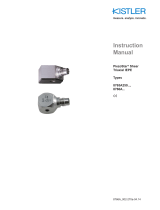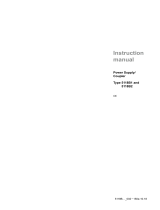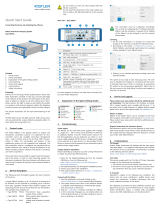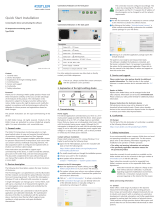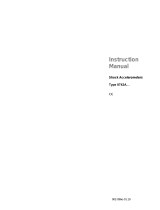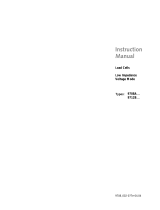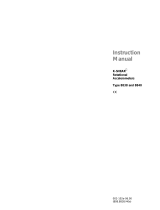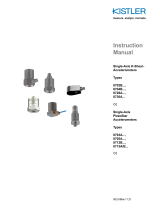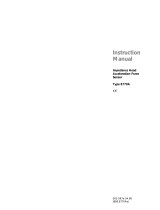Page is loading ...

Instruction
Manual
5114_002-149e-10.18
Power Supply/Coupler
Type 5114

Instruction
Manual
5114_002-149e-10.18
Power Supply/Coupler
Type 5114


Page 1
5114_002-149e-10.18
Thank you for choosing a Kistler quality product
characterized by technical innovation, precision and long
life.
Information in this document is subject to change without
notice. Kistler reserves the right to change or improve its
products and make changes in the content without
obligation to notify any person or organization of such
changes or improvements.
© 2000 ... 2018 Kistler Group. Kistler Group products are
protected by various intellectual property rights. For more
details visit www.kistler.com. The Kistler Group includes
Kistler Holding AG and all its subsidiaries in Europe, Asia,
the Americas and Australia.
Kistler Group
Eulachstrasse 22
8408 Winterthur
Switzerland
Tel. +41 52 224 11 11
info@kistler.com
www.kistler.com
Foreword
Foreword

Power Supply/Coupler, Type 5114
5114_002-149e-10.18
Page 2
Content
1. Introduction .................................................................................................................................4
2. Important guidelines ...................................................................................................................5
2.1 For your safety ....................................................................................................................5
2.2 Precautions .........................................................................................................................5
2.3 Using this manual ...............................................................................................................6
2.4 Disposal Instructions for Electrical and Electronic Equipment ............................................6
3. General description ....................................................................................................................7
3.1 Supplied and optional items ...............................................................................................7
3.2 Compatibility .......................................................................................................................8
3.3 Piezoelectric measurement concept ...................................................................................8
3.3.1 The high impedance sensor ..................................................................................8
3.3.2 The low impedance sensor ...................................................................................9
3.3.3 Low impedance measuring system .......................................................................9
4. Technical information, functional description .......................................................................10
4.1 Power supply ....................................................................................................................10
4.1.1 Supply current .....................................................................................................10
4.2 Bias voltage display .......................................................................................................... 11
4.3 Bias indicator (circuit integrity) ..........................................................................................11
4.4 Low battery indication ....................................................................................................... 11
5. Assembly, installation and operation ......................................................................................12
5.1 Unpacking and Mounting ..................................................................................................12
5.1.1 Unpacking ...........................................................................................................12
5.1.2 Mounting ..............................................................................................................12
5.2 Connections ......................................................................................................................12
5.2.1 Signal connections ..............................................................................................12
5.2.2 Power supply connection ....................................................................................13
5.3 Battery operation ..............................................................................................................13
5.3.1 Installation and operation ....................................................................................13
5.3.2 Battery back-up ...................................................................................................14
5.4 Front – top panel controls and indicators .........................................................................14
5.4.1 Power switch .......................................................................................................14
5.4.2 Bias voltage indication.........................................................................................14
5.4.3 Top panel .............................................................................................................15
6. Maintenance and calibration ....................................................................................................16
6.1 Calibration ........................................................................................................................16
6.1.1 Bias Test ..............................................................................................................16
6.2 Maintenance and repairs ..................................................................................................16

Page 3
5114_002-149e-10.18
Total pages 20
7. Storage and transportation considerations ...........................................................................17
8. Technical data ...........................................................................................................................18
8.1 Technicalspecications ....................................................................................................18
9. Warranty .....................................................................................................................................19
A Appendix – condensed operating instructions.......................................................................20

Power Supply/Coupler, Type 5114
5114_002-149e-10.18
Page 4
1. Introduction
Thank you for choosing a quality product from Kistler.
Please read through this manual thoroughly to enable you
to fully exploit the various features of your product.
To the extent permitted by law Kistler accepts no liability
if this instruction manual is not followed or products other
than those listed under Accessories are used.
Kistler offers a wide range of measurement products
through to turnkey solutions:
Piezoelectric sensors for measuring pressure, force,
torque, strain, acceleration, shock and vibration
Strain gage sensor systems for measuring force and
torque
Piezoelectric pressure sensors and transmitters with
matchingmeasuringampliers
Matching measuring ampliers (charge ampliers, pi-
ezoresistive ampliers, etc.), displays and charge ca-
librators
Electronic control, monitoring and evaluation units as
wellassoftwareforspecicmeasurementapplications
Data transmission modules (telemetry)
Kistler also develops and produces measuring solutions
fortheapplicationeldsengines,vehicles,manufacturing,
plastics and biomechanics sectors.
Our product and application brochures will provide you
with an overview of our product range. Detailed data
sheets are available for almost all products.
If you need additional help beyond what can be found
either on-line or in this manual, please contact Kistler‘s
extensive support organization.

Important guidelines
Page 5
5114_002-149e-10.18
2. Important guidelines
It is important that the guidelines in this section be obser-
ved. The information contained within this section will en-
sure both personal safety and years of trouble-free ope-
ration.
2.1 For your safety
This device has been manufactured and tested in ac-
cordance with IEC Publication 1010-1 (Safety Rules for
Electronic Measuring Equipment). To ensure operation wi-
thout danger, the user must follow the safety instructions
and warnings contained within this manual or inscribed on
the unit.
Local safety regulations regarding the use of AC line pow-
ered equipment must be observed.
2.2 Precautions
The instrument must be taken out of operation immediate-
lyifitisidentiedasahazardtopersonnelorequipment.
It must also be secured against accidental operation.
The instrument may be a hazard if:
It shows visible damage (e.g. resulting from abuse).
It does not function properly.
It has not been installed properly.
It has been stored in or subjected to adverse environ-
mental conditions (e.g. excessive moisture).
It has been exposed to harsh transportation conditions.
Storage or transportation of the unit should be in ac-
cordance with the recommendations given in Section 7.
The following are precautions which should be followed at
all times when using this instrument:
Make sure the instrument is operating on the proper
line voltage before power-up.
Never use the equipment in wet conditions.
Never expose the instrument to contamination or oil
mist.
Never operate the instrument if there are visible signs
of damage.
Isolate the unit from sources of electrical noise and vol-
tage transients.
Do not expose the instrument to environmental condi-
tions beyond those listed in the technical data.

Power Supply/Coupler, Type 5114
5114_002-149e-10.18
Page 6
Connect the instrument only to equipment for which it
was designed to be used.
Additional precautions are given in Section 6 which relate
to maintenance and calibration.
2.3 Using this manual
It is recommended that the user reads the entire manual
prior to operating the coupler. A thorough understanding
of this instrument will ensure the maximum utilization of
the many instrument features. A detailed table of contents
has been included to assist the user.
A convenient "Quick Start" section can be found in Appen-
dix A. This section provides the basic information required
to place the coupler into operation immediately without a
detailed explanation of the coupler’s functions
2.4 Disposal Instructions for Electrical and Electronic Equipment
Do not discard old electronic equipment in municipal trash.
For disposal at end of life, please return this product to
the nearest authorized electronic waste disposal service
orcontactyourKistlersalesofceforinstructions.

General description
Page 7
5114_002-149e-10.18
3. General description
The Kistler Type 5114 coupler provides the electrical inter-
face between low- impedance, voltage mode piezoelectric
sensors. This coupler provides constant current power to
Kisltler and other low impedance piezoelectric sensors.
This coupler is variously known as a constant current
source supply or ICP power supply. This unit can be po-
wered from an internal 9V battery. An external DC power
source, or an AC-DC power adapter (minimum 12 V input)
may also be used.
Type 5114 provides constant current excitation and re-
moves the DC bias component from the low impedance,
voltage mode sensor. Front panel indicators alert the ope-
rator as to the condition of the sensor, cable and battery. A
power on/off switch is also located on the front panel.
Fig. 1: Front Panel of Type 5114
3.1 Supplied and optional items
The standard coupler, Type 5114 is supplied in a hand-
held case that is suitable for stand-alone operation. Type
5114S1 option consists of Type 5114, a ruggedized car-
rying case, 9 V battery, AC-DC Wall mount power supply
adapter and instruction manual.
Type 5114 coupler operates from a 9 V battery. An exter-
nal DC power source or an external AC-DC "wall mount"
adapter (minimum 12 V input) may also be used.

Power Supply/Coupler, Type 5114
5114_002-149e-10.18
Page 8
Table 1 below lists accessories available for Type 5114
coupler. Also refer to Type 5114 data sheet for supplied
and optional accessories.
Quantity Description Type/
Mat. No.
1* Alkaline battery, 9 Volt 55129296
1 AC-DC wall mount power supply
adapter, 230/120 VAC to 12 VDC
5752
1 6 foot DC power cable mate to
pigtails
55131496
Table 1: Included (*) and optional items for Type 5114
3.2 Compatibility
Type 5114 is compatible with virtually all low impedance
piezoelectric sensors. Sensor types include Piezotron and
PiezoBEAM. This coupler provides constant current pow-
er to Kistler and other low impedance piezoelectric sen-
sors. The coupler is variously known as a constant current
source supply or ICP power supply. Type 5114 will also
power external impedance converters such as the Kistler
Type 557, 558 and many other “Source Followers” and
“Charge Converters” that require a constant current pow-
er supply.
3.3 Piezoelectric measurement concept
This section provides basic information about high and
low impedance piezoelectric sensors. The following de-
scriptions only cover how these types of sensors are used
with Type 5114 coupler. Technical papers are available
from Kistler for users that desire a more theoretical dis-
cussion.
3.3.1 The high impedance sensor
High impedance piezoelectric sensors convert mechani-
cal phenomena of pressure, force, and acceleration into
an electrical charge. The charge delivered by the sensor
is proportional to the force acting on the internal (piezo-
electric) crystal element. For the transducer, the calibra-
tion factor is given in picoCoulombs per mechanical unit
(e.g. pC/psi, pC/lb, pC/g, etc.).

General description
Page 9
5114_002-149e-10.18
Type 5114 coupler is designed for use with low impe-
dance, voltage mode sensors. The coupler can be used
with high impedance, charge mode sensors when used
in conjunction with an external impedance converter e.g.,
the Kistler Types 557 and 558. Kistler offers a line of du-
al-modeandchargeampliersforusewithchargemode
sensors. Consult Kistler for more information on instru-
mentation for charge-mode sensors.
3.3.2 The low impedance sensor
A miniature electronic circuit is built into the housing of
a low impedance sensor. This circuit converts the high
impedance charge signal generated by the piezoelectric
material into a voltage signal, with an output impedance
typically below 100 Ω. This allows the use of conventio-
nal, coaxial or two-wire cable between the sensor and the
remotely located power supply/coupler. Both the power to
and signal from the sensor are transmitted over the two-
wire cable.
Low impedance sensors are ideally suited for applications
where long or moving cables are required or in high humi-
dity or other contaminated atmospheres. They eliminate
the high impedance problems by providing a voltage sig-
nal with low impedance and a wide frequency response.
The calibration factors for these sensors are given in milli-
volts per mechanical unit (e.g., mV/psi, mV/lb, mV/g, etc.).
3.3.3 Low impedance measuring system
A typical low impedance measuring system consists of the
following components:
The sensor (with built-in impedance converter)
A power supply/coupler (e.g. Type 5114)
A read-out or display instrument
Appropriate connecting cables

Power Supply/Coupler, Type 5114
5114_002-149e-10.18
Page 10
4. Technical information, functional description
This section describes the functions of pertinent stages of
the coupler circuits. A review of this section prior to rea-
ding the operating instructions in Section 5 is recommen-
ded.
4.1 Power supply
This part describes the internal power conditioner as
shown in Figure 2. The coupler can be powered with one
9 Volt alkaline battery. Also, a user supplied external DC
power supply, or an AC-DC power adapter (minimum
12 V input) can be used. The coupler’s power conditioner
is equipped with the following features:
Reverse polarity protection.
Input voltage range of 12 … 24 VDC.
Battery lifetime of approximately 36 hours when using
a 9 Volt alkaline-zinc battery and accelerometer cons-
tant current at 2 mA.
Automatic switching between battery and external po-
wer. Type 5114 will select the input with the highest vol-
tage.
The power conditioning stage contains a voltage conver-
ter which converts the input power level (from battery or
external power) to approx. +30 VDC. Voltage regulators
furnish power, at the proper levels, to the various stages
of the coupler.
4.1.1 Supply current
A Type 5114 coupler’s constant current source supplies a
constant 2 mA to the connected sensor. For most applica-
tions, the 2 mA current supply is more than adequate. As
cable length is increased the cable capacitance becomes
signicant, thereby loading the sensor’s internal electro-
nics.Ifthecurrentisnotsufcienttochargethecableat
an adequate rate, high frequency distortion will be expe-
rienced. The following formula can be used to determine
the maximum usable frequency:
fmax (kHz) = (I – 1) ÷ 2π Vpp Cc
Where:
I = Sensor current (milli-amperes)
Cc = Total cable capacitance (micro-farads)
Vpp = Full scale signal amplitude (volts)

Technical information, functional description
Page 11
5114_002-149e-10.18
4.2 Bias voltage display
A 3.5 digit numeric indication of the bias voltage is dis-
played on the front panel. See Section 5.4.2 for more de-
tails.
4.3 Bias indicator (circuit integrity)
The bias indicator circuit consists of voltage comparators
and three LED indicators. The "Normal" LED is on when
the bias voltage is within the normal operating range. In
the event of a high or low bias voltage, the respective
"Open" or "Short" LED will light and the normal LED will
turn off. See Section 5.4.2 for more details.
4.4 Low battery indication
A comparator circuit constantly monitors the input voltage
level. Should the voltage drop below 6.5 Volts, a visual
"LOBAT" display will alert the user. A Low battery should
be removed or replaced immediately to prevent errors or
damage to the unit.
Fig. 2: Block diagram

Power Supply/Coupler, Type 5114
5114_002-149e-10.18
Page 12
5. Assembly, installation and operation
5.1 Unpacking and Mounting
5.1.1 Unpacking
Unpack the instrument and inspect it for any visible dama-
ge caused during shipment.
5.1.2 Mounting
Type 5114 coupler is designed to be used in eld and
laboratory locations (e.g., table, oor, etc.) without any
further mounting.
5.2 Connections
This section provides information on connector locations
for power and input/output signals. Information on cable
types is also provided.
5.2.1 Signal connections
Connect the low impedance sensor to the BNC negative
connectoronthetoppanelidentiedas"In".Sensorpow-
er is also supplied via this connector.
The conditioned output, without the DC Bias, is availab-
le from the BNC Negative connector labeled "Out" on the
top panel of the instrument.
Typical cables used with Type 5114 are listed in Table
2. User requirements may be different depending on
equipment terminations and the nature of the installation.
Consult the data sheets for the individual equipment to
be connected for the most complete information. Contact
Kistlerforcablecongurationsdifferentfromthoselisted.

Assembly, installation and operation
Page 13
5114_002-149e-10.18
Type Description
1631Csp Low noise, 10-32 to BNC pos., specify length
1939Asp Low noise, weldable 10-32 to BNC pos., specify length
1601sp Low noise, BNC pos. to BNC pos., specify length
1761B(X) General purpose, 10-32 to BNC pos., specify length
1511sp Output cable, BNC pos. to BNC pos., specify length
Table 2: Kistler cables
5.2.2 Power supply connection
External power is supplied via a top panel jack; "DC In".
The 5114 can be powered with a "wall mount" AC-DC
adapter, which supplies DC power to the coupler. When
using this power supply, simply plug the power supply
plug into the top panel jack of Type 5114.
When using an external power supply, optional Kistler
Type 55131496 accessory cable is recommended. The
cable is 6 feet in length, terminated at one end with a
standard concentric power connector (2.1 x 5.5 mm) and
pigtails at the other end.
The unit is protected from polarity reversal. See Section
4.1 for details about this feature.
5.3 Battery operation
5.3.1 Installation and operation
Type 5114 can be operated from one, 9 Volt, dry cell bat-
tery. The following battery can be used.
Battery type Battery life* (hours)
Alkaline-zinc 36
*With sensor current at 2 mA
The battery compartment is located at the bottom of the
case. To install or replace the battery, remove the cover
by pressing and pulling back on the plastic cover with one
nger. Battery reversal will not damage the coupler, but
will result in failure of the coupler to operate. Also, the unit
will continue to operate approximately one hour after the
"LOBAT" indication appears on the front panel display.

Power Supply/Coupler, Type 5114
5114_002-149e-10.18
Page 14
Residue from battery leakage should be removed
promptly and thoroughly from any surface with a damp
cloth since it is caustic (potassium hydroxide, KOH) and
corrosive. Caustic burns from alkaline cells must be
washed promptly with large volumes of water and receive
immediate medical treatment to neutralize the caustic
effects. Do not get battery residues in or near the eyes.
5.3.2 Battery back-up
If the coupler is going to be operated using external power
(DC source or power adapter), the user may remove or
keep the battery in the unit. If a battery is installed in the
unit, the user will have the added advantage of an uninter-
ruptable power source.
The coupler’s internal power supply contains an auto-
matic power switching circuit. This circuit automatically
switches between the internal battery and the input po-
wer plug on the top panel. As long as the input voltage to
the power plug is higher than the battery voltage, the unit
will derive its power from the external source. Should this
input voltage drop below the battery voltage, the unit will
switch to the internal battery provided the internal battery
voltage level is 6.5 volts or higher. In the event that the
unit’s battery is low, applying outside power turns off the
low battery warning.
If battery is left in the unit during external power operation,
the user should periodically check both the electrical and
physical condition of the battery and observe the caution
in Section 5.3.1.
5.4 Front – top panel controls and indicators
5.4.1 Power switch
The power switch is located on the front panel. See Sec-
tion 2.2 for precautions.
5.4.2 Bias voltage indication
All units are equipped with both front panel LEDs and a
3.5 digit numeric display panel that indicates the unit’s
bias voltage level. Bias fault indications can give the user
clues as to possible problems in the measuring system:

Assembly, installation and operation
Page 15
5114_002-149e-10.18
The green "Normal" LED indicates that the bias voltage
is within the normal limits of 4 to 16 Volts. The other
LEDsareidentiedas"Short"and"Open".
A yellow "Open" indication (>16 Volt display) is usually
caused by an open or disconnected cable. If replacing
the cable does not solve the problem, the sensor is
most likely defective.
A red "Short" indication (<4 Volt display) is caused by
a short in the cable or sensor. If a "Low" indication is
detected, disconnect the sensor. If the bias voltage re-
mains low, replace the cable. If the bias voltage goes
"High" the short is in the sensor.
Types 8614A500, 8616A500, and Type 8694M1 Model
Accelerometers have a lower output bias than standard
Piezotron Sensors. This bias may be below the sensor’s
nominally rated 4 volt level and will cause the 5114 "Short"
LED to become lighted (Red) and a low bias value will be
displayed on the digital panel meter.
The accelerometer’s actual bias level will be indicated on
the Liquid Crystal Display. A normal operating bias level
for the three accelerometers will be in the range of 2.5 to
5 VDC
5.4.3 Top panel
The following receptacles are located on the top panel of
Type 5114 going from left to right:
"In" – BNC connector is provided to connect a low im-
pedance, voltage mode sensor.
The "DC In" plug is used to furnish DC power if the in-
ternal battery is not being used.
"Out" – BNC connector provides the conditioned sen-
sor signal for connection to a readout instrument (oscil-
loscope, meter, etc.)
Fig. 3: Top panel of Type 5114 coupler showing the
power connector and input/output connectors

Power Supply/Coupler, Type 5114
5114_002-149e-10.18
Page 16
6. Maintenance and calibration
6.1 Calibration
Type 5114, as with other measuring instruments, should
be calibrated annually to ensure accurate measurements.
Kistler will calibrate the unit with sources traceable to the
National Institute of Standards and Technology (NIST).
From time to time the user might want to check the instru-
ment calibration to ensure accurate test results. There are
twoteststhatcanbeperformedtoquicklyconrmproper
instrument operation; a bias test and a signal test.
6.1.1 Bias Test
With the unit power applied, disconnect the sensor from
the top "In" BNC connector. The "Open" Bias Indicator
LED should light.
Using a short length of wire, short the "In" BNC connector
by connecting the wire between the center conductor and
the outer ring of the connector. The "Short" Bias Indicator
should light up.
With a sensor connected, the "Normal" indicator should
light provided the sensor and cable are operating properly.
Should the unit fail any of the above tests, contact the
factory or your local representative/distributor for further
instructions.
6.2 Maintenance and repairs
No periodic maintenance is required. Factory repair is
recommended where trained personnel and appropriate
measuringequipmentandxturesareavailable.
Always remove all sources of power from the unit befo-
re cleaning. Use only mild detergent or isopropyl alcohol
when cleaning the exterior of the case. Do not allow any
of the cleaning solutions to enter the case. allow the case
to dry thoroughly before returning the unit to service.

Storage and transportation considerations
Page 17
5114_002-149e-10.18
7. Storage and transportation considerations
If the instrument is to be stored for an extended period or
transported, the following precautions should be taken to
assure safe conditions:
1. The temperature should be maintained between
–20 °C and +60 ° C.
2. Always remove the battery prior to storage.
3. All BNC connectors should be covered with non-
shorting dust caps.
4. Contamination must be prevented from entering the
unit.
5. The environment should be dry and as free from
vibration as possible.
6. Do not store or transport the instrument in such a
position such that pressure is placed on the top, front
or rear panels.
7. When not in use, the instrument should be stored
in the original packing materials or carrying case
whenever possible.
/

